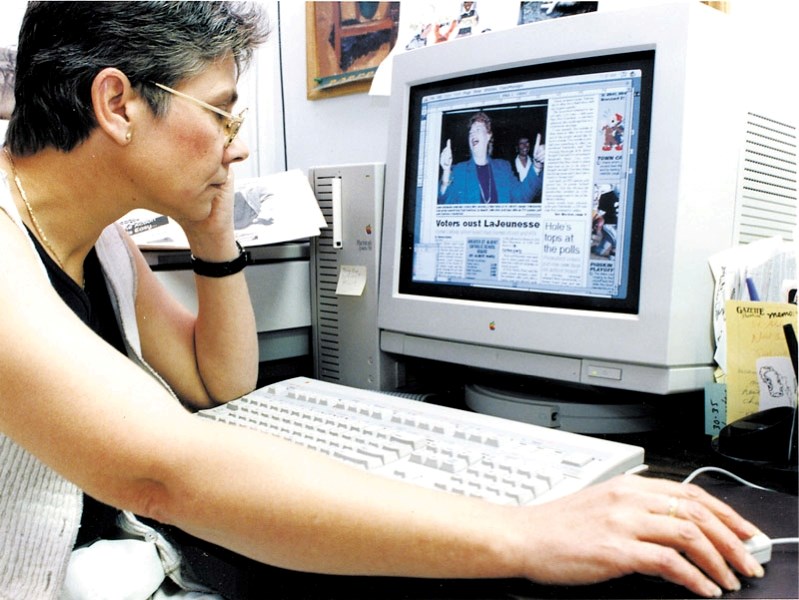At a newspaper, the editor is the person responsible for ensuring the right stories get covered the right way, that the writing is clear, accurate and grammatically correct.
Like a ship's captain, the person at the helm of the newsroom is intimately familiar with all the vessel's workings and is responsible for setting its direction. During the Gazette's 50 years only about 10 people have held the title of editor. The first was founder Wim Netelenbos, who started the paper in 1961.
For the first year the paper mostly acted as a collector of news and information supplied by the community. But by the second year editorials bearing Netelenbos' initials were appearing on the front page.
"The board completely changed its mind … which is not only disappointing but also inconceivable," he wrote on Feb. 10, 1962, chastising the town council for going along with a plan to integrate St. Albert telephone numbers into Edmonton listings.
When the husband and wife team of Ernie and Shirley Jamison took over the paper in 1966, Ernie became the sales guy and Shirley filled the role as editor (even though Ernie was officially listed as the editor). During her tenure, it wasn't uncommon for editorials to appear on the front page with some sentences appearing in all capitals for emphasis.
Former Mayor Richard Plain remembers the Gazette being very focused on town council and its effect on citizens. Even its news stories had an opinion flavour to them, he said.
"It wasn't a passive role. It was very lively, opinionated views," Plain said. "That added a spice to the Gazette."
People really looked forward to seeing the St. Albert Gazette when it came out each Wednesday, he said.
"The St. Albert Gazette would get read ahead of the Edmonton Journal because it reported what was happening in your community. You had a strong editor with strong opinions, more or less on the pulse of things," Plain said.
Vicky Knight followed Shirley Jamison into the editor's chair and would stay for about two years. She would later become an editor at the Edmonton Sun.
Ernie and Shirley's son Duff, who worked at the paper as a teen and returned after university, moved from reporter to editor in the late 1970s.
Jamison would soon move up to publisher. One of his strategic moves was to join newspaper associations in an attempt to learn how other papers did their work and apply the best practices to the Gazette.
In an attempt to improve the quality of the writing he began hiring people who'd completed post-secondary journalism training.
"If you're going to do something, why wouldn't you do it as well as you could?" Jamison said.
Before going on to a successful career as an Edmonton Journal reporter and columnist, a mid-20s Scott McKeen was the Gazette's editor for two years in the mid-1980s.
McKeen continued to report on city hall while acting as editor. Because the paper already had a stable of reporters who were largely self-directed in covering their beats, his editor's duties mostly involved deciding which photos to run and where to place stories in the paper. This aspect was very satisfying.
"Being the managing editor of the Gazette was the best job I've had in journalism because there was so much creative control in that position," McKeen said.
Ian Hamilton, who followed McKeen as editor, would also go on to work at the Edmonton Journal.
Shaping opinion
One of the editor's roles is to write the editorial that appears in each paper. That function traditionally aims to expose societal wrongs, critique government decisions, or stimulate action in the community.
"If I saw people in the community trying to make a difference I would try to write editorials that would help with that," said Cheryl Moskaluk, who spent two years as the Gazette's editor, ending in 1992. (She was Cheryl Hesse then.)
After Moskaluk left to have a family, assistant editor Sue Gawlak moved into the big chair. She would go on to be the longest-serving editor in the Gazette's history, holding the position for 18 years. In 2010, Gawlak's life was cut short at 59 when she lost a two-year battle with breast cancer.
Plain remembers Gawlak as a person who was always interested in how city hall decisions affected the common person.
"Sue in her time tended to give voice much more to the ordinary citizen issues that would be coming into council," Plain said.
Gawlak was very organized and delivered a good quality product day in and day out, Jamison said. She also had a strong social conscience and wasn't afraid to tackle sensitive issues.
"The Gazette covered all kinds of issues that may have made people uncomfortable," Jamison said. "Sue took her role of editor very seriously. She understood that people relied on the Gazette to be their eyes and ears."
During Gawlak's tenure, the paper was influential in steering public opinion on some issues, Jamison said, such as its repeated support of the west bypass that eventually became Ray Gibbon Drive.
After Gawlak's health forced her to retire, Peter Boer and Bryan Alary became co-editors. The pair of former city hall reporters was known to joke that it took two men to fill the shoes of one woman like Gawlak.
In 2011 a new editor took over the reins. Retired Edmonton Journal veteran John Korobanik became one of the rare news people to make the step from a large daily to a community paper.
"It may seem strange but we don't think of ourselves as just a community newspaper," Jamison noted. "We think of ourselves as the New York Times of St. Albert."




